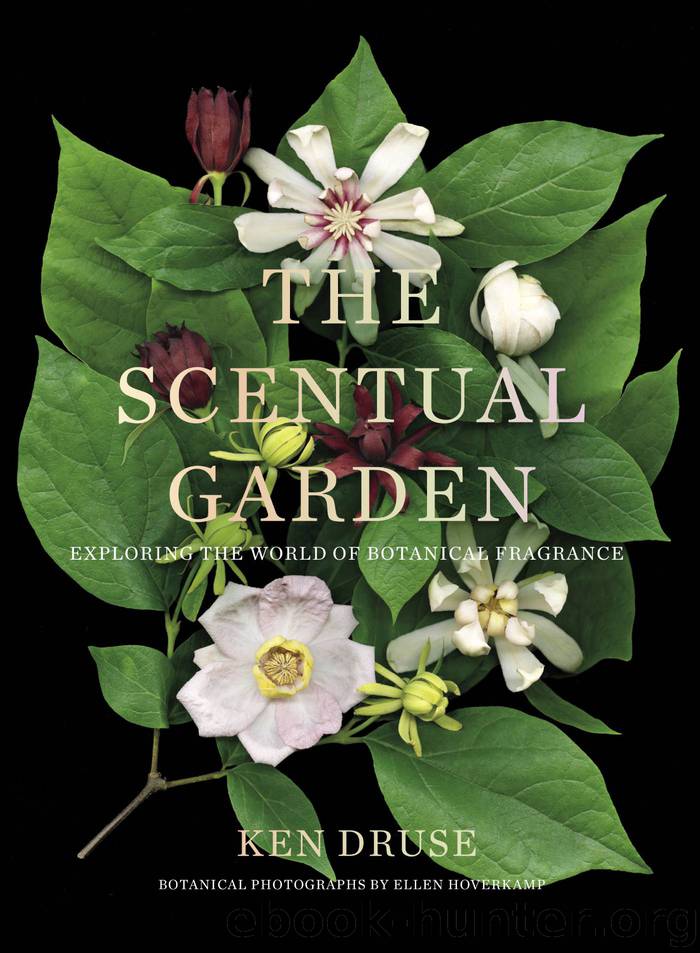The Scentual Garden by Ken Druse

Author:Ken Druse
Language: eng
Format: epub
Publisher: Abrams
Published: 2019-10-15T00:00:00+00:00
HERBAL/GREEN
Herbaceous smells are green smells. The smell of soft growth. Green notes in perfume are described as fresh, vegetal, crisp, and lively. Imagine a juicy stem being snapped. In French perfumery, the green category of smells is called fougère, the word for “fern.”
When you read “herbal/green” here, don’t think just of plants for flavors. Think of the fragrances of lawn grass, green peas, new-mown hay—of chlorophyll, from the Greek chloros (green) and phyllon (leaf).
The herbaceous annuals or perennials of the world are the non-woody plants with soft tissues. The short version of the word “herbaceous” is “herb.” But when we hear “herbs,” we think of culinary plants known for their flavors. Here, we’re investigating the herbaceous plants mostly for their fragrances.
Galium odoratum, sweet woodruff or sweet-scented bedstraw, with tiny white flowers and starlike leaves, is the small ground cover in this woodland mix.
Erysimum cheiri ‘Apricot’ is a wallflower that smells mostly like violets with honey, herbal/green, and anise, along with light jasmine and orange blossom.
For example, sweet woodruff, Galium odoratum, an aggressive spreading herbaceous ground cover for shade, is also called scented bedstraw. It is usually said to smell like new-mown hay. I also detect a bit of raisin. The potency increases with drying, and dried leaves are used in sachets and potpourri, and as a flavoring for May wine, traditionally served to celebrate May Day.
Valerian, Valeriana officinalis, is not a culinary herb but a mysterious plant known for the healing properties of its leaves, stems, and roots. All the parts are fragrant. Ellen thought it smelled like celery, perhaps because she was handling cut stems, or was just too close. The flowers’ sweet aroma, which lends the plant its other common name, garden heliotrope, is best sampled on the breeze. From a distance, the flowers smell like vanilla (with a touch of spice). Up close, a hint of locker room. Colorful Centranthus ruber, called red valerian, isn’t related. If grown in dry, infertile soil, it has a honey scent.
Valerian’s celery scent isn’t too far from the aroma of anise, another smell common in herbaceous plants, such as fennel, dill leaves, anise hyssop, and Pimpinella. In wallflowers, Erysimum cheiri syn. Cherianthus cheiri, ubiquitous biennials in Britain, there’s a hint of anise behind the smell of voilets.
I’ve placed scented geraniums, too, in the herbal/green category. These plants are not in the genus Geranium but in Pelargonium, and include the hothouse or windowbox plants with fire engine–red flowers and pungent leaves. The scented pelargoniums mimic the smells of other things: apple, coconut, nutmeg, lemon, rose, and the like. They all have a green background and, like other fragrant herbs, must be bruised for the leaves to release their redolence.
I considered including mints in this category because their tissues are herbaceous/green—and some have culinary uses. But others have strong, biting odors, so I’m relegating them to the medicinal category. Although spearmint and wintergreen are softer and sweeter, they are going to join the mints with peppery, piercing odors.
The blue flowers and leaves of borage (Borago officinalis) taste like cucumber.
Download
This site does not store any files on its server. We only index and link to content provided by other sites. Please contact the content providers to delete copyright contents if any and email us, we'll remove relevant links or contents immediately.
| Gardens | Landscapes |
| Plants & Animals | Underwater |
Shoot Sexy by Ryan Armbrust(17142)
Portrait Mastery in Black & White: Learn the Signature Style of a Legendary Photographer by Tim Kelly(16484)
Adobe Camera Raw For Digital Photographers Only by Rob Sheppard(16387)
Photographically Speaking: A Deeper Look at Creating Stronger Images (Eva Spring's Library) by David duChemin(16161)
Bombshells: Glamour Girls of a Lifetime by Sullivan Steve(13108)
Art Nude Photography Explained: How to Photograph and Understand Great Art Nude Images by Simon Walden(12348)
Perfect Rhythm by Jae(4621)
Pillow Thoughts by Courtney Peppernell(3397)
The Book of Joy by Dalai Lama(3218)
Good by S. Walden(2915)
The Pixar Touch by David A. Price(2740)
Fantastic Beasts: The Crimes of Grindelwald by J. K. Rowling(2543)
A Dictionary of Sociology by Unknown(2518)
Humans of New York by Brandon Stanton(2379)
Read This If You Want to Take Great Photographs by Carroll Henry(2303)
Stacked Decks by The Rotenberg Collection(2270)
On Photography by Susan Sontag(2130)
Photographic Guide to the Birds of Indonesia by Strange Morten;(2088)
Insomniac City by Bill Hayes(2084)
